






A big brown moved gently back and forth in an easy current, rising to snatch surface. This was a brute of
encounters are rare and can bring on a case of the jitters, The wind was problematic
required a tag team ‘spotter’ approach from the far bank. After a few failed casts, needed to be overcast 3 or 4 metres up an inside channel, close to the river bank and This allowed the leader and tippet to land wind blown backwards and sideways about a metre in front of and unconventional, its roughness disguised in the windy conditions. As the wee size 14 Dads Favourite surfaced and engulfed the one.
Draining the mountains
just south of Lewis Pass are the Doubtful and Hope Rivers. We had seven days backcountry rivers and, by leaving our vehicle at Windy Point, we could tramp up to the Doubtful River, then we could cross the Doubtful Range via the steep Lake River, and complete a loop back to our vehicle.
The area is served by well marked tracks and comfortable huts. We made it to the two-man Doubtful Hut just before a large group of North Canterbury Deerstalker Association hunters. No matter, they were well equipped with tents and bivvies. As we also like to hunt, they were great guys to yarn with over a brew and were very giving of their time and knowledge of the area and game numbers.
the Doubtful and four days overnighter on the Doubtful Range tops, under a week of clear skies. Let it be said though, with low and clear river conditions and westerly head winds every day, challenging. Fish were ‘spooky’ but not uncatchable with good presentation and days and well earned

rewards, but not for the faint patience and perseverance bit.
It could not be harried or muscled or out gunned.
Only gentle persuasion and time would win this battle, or it would be tears in the teacups tonight. Eventually, time prevailed and we
pulled down to 11 and a bit
This scenario had played out in my head many times over before I had headed up

perch lake. Arrival at the new body of water came with huge anticipation for what might unfold on this beautiful late autumn day.
I cast a small perchcoloured soft-bait around the weed margins, hoping to lure out an adult perch who was keen to cannibalize one of its own. This may sound unusual, but not for perch populations. Typically, rule over the juveniles, feeding ravenously after each spawning season.
shallows, hoping to scrape by until they are large enough to avoid predation by the adults.
It was a tough day but I remained optimistic. I covered the water for a few hours and eventually stumbled upon a crystal
running along its edge.
more importantly the soul. A snapshot of our dreams lay in the folds of that net. We had been truly blessed.
Held gently upright again
regained its strength and swam slowly away upstream
out of our grasp. The but not forgotten. We had time to lay on the river bank in the warm afternoon sun and soak in this backcountry paradise— no doubts now, but freshly
terrain. Quickly, I scaled onto the platform and realized how good the vision was.
Out of the corner of my eye; movement. As my vision adjusted under the shade of the willow trees,
lazily swam into view. Not wasting any time, I threw out my small paddle tail, off into the distance.
I wanted to bring this prey in nice and naturally. As my retrieve neared the perch, perfection. The fish shot o straight at the lure and crushed it—my heart in my mouth at this stage.
I scrambled down the
easily slid into the net, after a short protest. Not only did I get a stunning bite from coloured up. Its blazing red
a burst of colour as I held it up for the camera.
The confused perch was carefully returned to the water, where it quickly headed for cover. Pressure off, the rest of the day could now be enjoyed without fear of going home empty handed. The perch came out in droves throughout the afternoon, with the bite peaking just as the sun began to set. I had well and truly worked out where they were sitting at this point, most cruising the ankle deep water, shoving their heads a quick snack.
before the carpark, I had an hour of bliss. Big perch after perch was landed, including an amazing double of two
my efforts—it turns out that Friday the 13th was luckier than I thought.







which involved sending a stream, using the strength of the water to pull line from went under or it was out of sight. Then you reeled in and started again. This type me was nothing like that.
Much easier!
It was advertised as a there is no road access and by a sandbank opposite the lodge and be picked up by one of the lodge boats— but
It also advertised great salmon, rainbow trout and rainbow trout and grayling I had chosen Riversong Lodge..
I learned shortly after arriving that the rainbow was so low the guides could not get the boats far enough upstream to where the good salmon before in Canada,
The Yentna River is a glacial river with a heavy silt load— put your hand in the water and before you get your wrist wet, you can not see your it has an enormous run of different times of the year. It time.
We motored down river to a place called Indian Pond, a backwater off the Yentna river. As we idled into the backwater, it looked like we had come to a parking lot for boats. Around the shoreline were moored about thirty boats, all nose into the shore and the sports sitting at the stern holding a rod. We put our nose into the bank and tied up to a convenient bush. Daryl then set up the rod: spool reel, loaded with 30 or

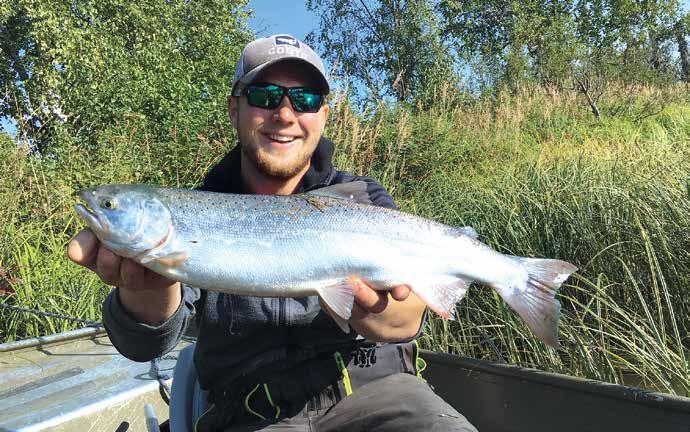
enough weight to cock the silver salmon eggs on a size 1/0 hook.
were to take advantage of an evolutionary quirk of nature—hen silver salmon will eat the eggs of another silver salmon to increase the chances of her eggs hatching and most of the salmon being caught were females.
swimming around the backwater—you could track
under water. I struck and was attached to a very lively salmon.
“Hold it, hold it,” advised Daryl. “Don’t let it run.”
The need for 30-40lb line became apparent, as I clamped down and let the
collected the lines of other un-holy mess to clean up.
After several minutes Daryl it into the boat. I did not but offered any to Daryl, so it got knocked on the head the boat.
Ten minutes later the pod and we repeated the above. Ten minutes after that the we did it all again.
None of the other boats was a pure meat hunt. I’d had enough and slipped away.
Twenty minutes up-river we turned into a clear water on one side. Past the camp, we dropped anchor and rods. It should have been an ideal spot, as silvers like to pull out of the main current into slower water to rest before continuing the rush
and, after a few hours, we only had two blue cod in the bin. As lunch time was fast approaching, it was time to have a look through
We were just about to leave pre-planned spot when the wind picked up, so changed our plans and headed to the calmer east side of Blumine Island.
We set the anchor and the action was very slow
Nearing the slack tide, I changed to a light rod and cast a green micro Kabura jig towards the shore. As the micro jig slowly and steadily dropped through the water, I detected a light bite on the rod, which suddenly
large bend in it. It was unusually heavy and I felt like the lure had snagged on the weedy and rocky bottom.
As I started to wind slowly, the rod continued to bend even further, but the line was now steadily winding in. I felt nodding and a came through the weedline. Finally, it was free of weed and rocks and being wound in towards the boat.
As blue cod got closer to the surface, I realised I had a
double hook up—two blue cod on the line. Quickly, I reached for the landing net the boat..
To my surprise, those tiny little Kabura hooks had hooked the two blue cod solidly in the side of each of their mouths.
We now had our blue cod quota, so it was time to pull up the anchor and head burger.
up-steam to spawn, but we so stowed the rods to return to camp. Daryl reversed the boat to free the anchor and the motor died.
He took the cover off the outboard motor and went looking for the problem. Drifting back towards the Yentna River, we were hailed by a guy from the camp asking if we needed a hand. I lay on the bow and hand paddled us close enough to throw him a rope.
Pulled to the shore I did the most useful thing I could do, which was stay out of the inner workings of the motor. They eventually determined that a part had broken and if they attached this to that, we should get back to the lodge.
Firing up the engine after into the Yentna—only to have the motor cut out again. Daryl restarted it immediately but we had lost reverse, we had power just above idle—enough to move
stern up-stream and puttered across the mile wide river.
I then noticed we did not have any oars and no cell phone coverage. Alone on a swift river going backwards against the current.
fun!
aiming to get far enough across for the river to take us between the sandbank and the camp. The only minor obstacle was the dead trees and brush we had to navigate without getting stuck or worse in.
We arrived at the point of the sand bank and hit the trees, thankfully a glancing blow, which spun us around down the channel. One of the other guides put his head over the bank and helped us pull into the camp boat dock.
The only comment I got from the staff at the lodge was that I was late for lunch!!!








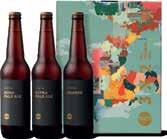


















Carol Scott is Chief Executive of Southern Inshore Fisheries Management Company Ltd (Southern Inshore). In this article, she provides an insight into
keep their footprint light.
undisputed that it touches and disturbs the seabed
same limited spots typically returned to annually or seasonally. This is called the trawl footprint.
Fishers aim for the lightest footprint possible. They do
where there are lots of rocks or coral) as this can cause damage to gear, as well as increase fuel usage through increased drag on the gear.
I would like to offer some factual insights in bottom
Nelson Marlborough region where I live. Here, skippers vessels in the shallower waters of Tasman Bay and Golden Bay and beyond, soft mud, sand or gravel.
The gear used on a trawl is designed for the area being size of the target species and the size of the vessel.
The gear is also designed and chosen for the type of sand or gravel terrain means to catch their quota of the healthy seafood we enjoy so much.
Trawl footprint
Just like land-based food production, bottom trawling

Trawling on rough ground can also affect the habitats that support the life-cycle of
just as aware of as they are the state of their capital investments.
Unlike land-based food production where huge tractors, trailers, cultivators and harvesters are a regular sight in paddocks and on
a mystery. You can only see what bottom trawling looks like, to any degree of accuracy, while it’s happening underwater. This
often-misleading drawings or animations portraying bottom trawling.
a light touch on that softer seabed I’ve mentioned.
Most gear used by coastal
the footrope, as shown in the photo below or simply a wire wrapped with rope for
small rocks and other debris from being caught where it
the end of the trawl net).
shows the chain ground gear attached to a footrope.
is of a fully-
small distance between the attached to the headline
provide the buoyancy to open the top section of the net that is essentially a cone shape, with larger mesh at the front end and the mesh size getting smaller towards the cod-end.
The graduated mesh size
at the front end of the net
towards the cod-end. While the minimum mesh size
choose to use a larger mesh
achieve a more precise and sustainable catch.
are built into the nets to
catch, out of the net. The design and placement of these panels is determined by the studied behaviours
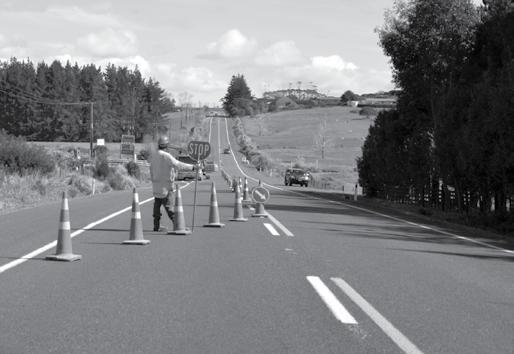



a fascinating aspect of ‘net tech’.
A more precise catch, with less sorting on deck needed, means shorter trips and less fuel. This is something I’m sure most readers can
appreciate, with the price of fuel right now, but it’s
lighten their footprint.
The other components of a bottom trawl net are wires sweeps) attached to the wing-ends that lead up to the boards). The doors act as a spreading device to open the trawl out, with the headline
the doors to the vessel and their length is determined by the water depth.
For the Mustang, hunter, fisher, tractor, car enthusiast, man-cave and more, there is a sign here on display at our show room to suit everyone. New stock arriving daily now for Christmas so visit us at Ellis Street Auto, Ph 03 542 4035 104a Ellis Street, Brightwater, Nelson From only $30 these signs make amazing gifts




Bottom trawling is very limited and highly regulated
trawling is one of the most to catch the types of species abundance on or near the They include family-meal favourites such as tarakihi, gurnard, snapper and
Whilst some of these species may be attracted to a baited hook they are not generally caught in volumes that provide for economic are simply just not attracted and show no behavioural traits to go to a baited hook, pot, trap or set net—instead, they need to be herded, like sheep!
As mentioned, bottom trawling has an impact, like any type of food production.
But unlike other food production, the area trawled is very limited.
New Zealand has one of the largest ocean territories in the world, but less than in our territory is trawled each year. Fishers return to the same grounds each year and, thanks to net tech, other and abundant grounds, are using fewer trawls to catch the same amount each year.
Only 10 percent of our
seen bottom trawling. Within the EEZ a third of the waters have been closed either through regulatory measures or voluntary initiatives led by or seabed habitat integrity.
The management of species in our waters are closely monitored and managed. How this is done is a topic for another time; for now I’d
a mention of the FV Emma J
I chose this photo of the FV Emma J because she is a typically-sized coastal trawler that you’ll see coming into coastal ports— hardly the colossus portrayed
Vessels sizes differ depending on the depth and there are restrictions on larger vessels operating in many inshore areas. But the Emma J owned by Herb of its type. I encourage you vessels in your closest port and if you get the chance, how they catch their quota. I do that as often as I can and always walk away with new and trustworthy information.




Management Company
a commercial stakeholder organisation representing a range of stocks, primarily in
Their main mandate relates to subjects such as setting Total Allowable Commercial
also takes responsibility for operational matters like establishing seabird risk mitigation practices on vessels and representing
processes such as discussions regarding marine protected areas or marine farming consents to mention a few.
closely with Fisheries Inshore New Zealand for effective


approaches to national and regional issues as well as liaising with regional government agencies such as Fisheries New Zealand and Department of Conservation and conservation matters respectively.

Mother Nature has turned it on for me. There’s a full moon reluctant to leave the western horizon and a rising sun scrambling up in the east. There’s a cracking frost lying among the golds and reds of late autumn and there’s a pair of homebred dogs, mother and son, who share my enthusiasm for an outing.
As I accelerate towards feeding stags break for cover. Their route is uphill, with many an obstacle. Their heart rate is red-lining as they strive towards top speed gallop, which will run them clean away from me. I try my ute, to panic them into turning back or making a last few metres they need just in time.
On toward the end of the block; a narrow tongue
of mature pines, which is occasionally the hide-out for pigs that roam the adjoining farms in the moonlight. To the left and to the right, a long jog away, there are groves of oaks. Acorns are currently dropping to the ground and wild pigs love ‘em. Vitamins, fats and carbohydrates wrapped in a husk that a hungry grunter can crack-roll-spit in mere seconds.
Dogs out, collars on, goosebumps, piddling and all the pre-hunt rigmarole. Then we’re off—yee-ha!
The dogs can smell evidence of a moonlight wanderer on the pineneedles covering the old forest track. There is an urgency to them, which tells me we’re in for a rapid run real soon. No time then to tracking receiver, just watch the dogs, then track their scuff marks in the damp soil as they race out of sight.
For almost a kilometre the dogs’ prints are visible on the track. They’ve been as their quarry jogs towards his daytime den. It’s then I hear the ruckus ahead and then comes the dread.

The dogs are holding. They’re between the forest track and the river. The river has carved a narrow gorge between rock walls over a period of centuries. The rock walls are ragged, rugged and bluffy. On the ledges and in the crevices, vegetation has got a root-hold—sycamore saplings, barberry thickets, blackberry tangles—even wee terraces of rank grass. In places the drop-off is pig could die here. Dread becomes joy as I stampede from pine edge to scrub belt. There, far below, the dogs and pig have reached rock-bottom and now they all splash and struggle in the river bed.




No.8 bow strings epitomise New Zealanders can-do approach to life.
Designed by Advanced Archery’s Carol and Kevin Watson for our rugged conditions and made right here in New Zealand.
We’ve refined the latest string building techniques, equipment, and materials we use through constant field testing to get the string quality we’re excited about. Go Kiwi with all black or choose from thousands of colour combinations with clear serving to customise it your way.
Pre-stretched for zero peep rotation, with speed buttons installed and a bow tune, we’ll send your bow back to you shooting as good as new, maybe even better!

My turn to navigate the gorge-wall now. To detour around the prickle thickets and crawl among the pig tunnels. Then there’s a section that stops me in my
a dry dirt surface that won’t hold a boot-print nor the human adjoined to it. I plonk my bum at the top and wriggle to the edge.
In a shower of dust, I slide pell-mell. My feet strike the base of a tree, its lower branches tear my face. Ouch!
among the large boulders at the river’s edge, then wade in to help the dogs. Their
and he’s better equipped for the conditions than they are.
Poaka has been crossing this river every night, travelling from bed to feed; he knows it well and he sure can swim.
After wading navel-deep, stumbling over slippery boulders, wrestling in the river sand and generally getting wet, cold and bedraggled, I assist my mates in overcoming their quarry.
bruised and bleeding and I’m not much better off. Despite that, I’m ridiculously happy. Wet and tired dogs are a huge relief; it could have been far worse.
the river and prep his carcass before tethering it to a
submerged branch. The chill water will cool it and keep back. Then it’s yet another deep crossing back to the foot of the bluffs, followed by a hands-and-knees crawl back to the forest track.
Its only seven degrees when we arrive home but the sun has begun to warm the world. The neighbouring farmer gives me permission to cross his paddock to retrieve Poaka from the river bed, the dogs are now housed and fed, my saturated clothes and boots are shed. A hot cuppa out on the porch then, no candles, no cake but as birthdays go, this one is gold.


TT
Adam has a long history with the company, having worked for them in the past and also having a used their his many adventures. Adam working with the team at Composites and was really impressed with the way they have grown their many well known brands like Okuma , CD Rods, Trycd , Pakula ,Pro
the show. As part of what I do as an ambassador for the brands I will be doing a lot of social media content as well as public appearances to get the most out of the gear and tips and techniques to help everyone with their
The new season of Fishy Business will be screening on Prime TV towards the end of 2022 and will feature trips around New Zealand
targeting all the popular species. Nick Binks, who heads up Digital sales and Marketing for Composite
commented, “ We are happy to be working with Adam as he is well respected in the industry and has a good following in all areas of the will be using a good cross section of our product range gear to inshore bait and lure tackle being put through its situations is a great way to show the development that has gone into our brands.”



Built in Wellington in 1911 by highly regarded boat builder Ralph Millman, she was of heart kauri, the hull double skinned with two tons of lead in her keel.
performer built to cope with rough weather and had made numerous crossings of
Over time, the group of
they put Windward through her paces and became familiar with every aspect of her performance. The boat was immaculately maintained; all equipment kept up to date and every available navigational and safety aid available at this time was on board.
It was Christmas morning 1930 when Windward sailed out of Wellington Heads bound for the Chatham Islands, arriving safely and to a great welcome from the locals who proved to be great hosts.
uncertain weather forecasts looming, the crew decided it was time to head for
home. This proved to be a slow trip taking nine days before she was sighted by another vessel off the coast of Cape Palliser, under full sail heading for Wellington Harbour. It appeared that all was well.
When Windward failed to show up in Wellington, searchers began looking for her or any trace of her.
not even a single piece of wreckage, no bodies and no single item carried in or on the vessel.
Today the mystery still to Windward


• Perfect for mounting thermals, night vision and red dots.
• Rail can be shortened at the front on request to sit flush with the front of the receiver.
• Some fitting may be required by a gunsmith as M77 action recesses can di er, no drilling and tapping required, buy New Zealand Made
Boots, and I must say they are the most comfortable boots I have had in years. I was VERY sceptical at buying online as have normally had to try boots on before buying, even when continually buying the same brand/model. The online
easy to order, great sizing chart, and the boots arrived on farm in three days.
well priced and feel like a real work boot should. I’m in my boots 99% of the year and only wear gumboots when it is REALLY wet on the farm so will be interested to see how these go. Currently my boots last just on 12 months before the leather cracks above the sole and they start leaking. Highly Recommend Earthwalk, great to deal with.
Alan - Canterbury 2/2/2022

Great boots, lots more wear than John Bull equivalent used in the past which always failed along the wear but in these uncertain times, have just ordered a replacement plus a laceup for the future.
10/5/2022
past more than twice this article's price for garments which let me down on a wet day. More than happy with item.
My husband has the coat and bib pants. They are very strong, long lasting, light weight and durable. It is enjoys wearing.
Mariann 01/11/2021
waterproof, have paid in the
:
The classic slim design housing of the new Thermion a seamlessly integrated
channel. With a measuring distance of up to 800 metres, accurate sense of distance for a precision shooting. The scope’s thermal detection range of up to 1800 metres in combination with the LRF capabilities.
ideal for shooting from great distances. The Thermion
either doubling at each step or continuously, enabling
Use the “Picture-inpicture”mode for a high

precision zeroing frame. Covering only 10% of the total display area, the frame the target and a reticle. It shows both a close and clear view of the aiming area while giving visual control of same time.
The Thermion’s memory contains ten reticle type, ballistic, scalable, and regular), all available in nine different colours.
PRO with unprecedented sensor sensitivity of NETD<25mK, ensures perfect detail recognition even in the most severe weather conditions when thermal contrast is low.
results in sharp and richly contrasted thermal imaging and peculiarities of the landscape.
Ultimate detection
lens. When paired with
Why the Banana Boat
Cicadas screamed, so for a swim. In retrospect there were some wonderful positives—beautiful day, a cool walk in lovely lakeside forest, birds singing and later we even found a koura, Fifteen centimetres from claws to tail but from the outset Murphy had nasty tricks up his slimy sleeve. Cameron arrived on time
out; the key to the trailer coupling lock was missing, but being resourceful I said, “Plan B will be a walking stalk around the lake margins.”
valley, then BANG, one of our feathered friends bounced off the windscreen into oblivion. Hate that.
The lake cheered us up,
jet skis breaking the 5 knot limit. Hate that as well. Their wash made it very hard to scan the water, then

the high sensitivity thermal sensor, it offers the highest possible quality and most detailed and informative imaging under any hunting conditions.
a prolonged operation time. It is powered with two rechargeable batteries: one built in and a replaceable
You’ll be able to enjoy up to 10 hours of hunting time on a single battery charge.
e
• Robust, reliable all metal housing. Reinforced yet lightweight aluminium alloy body construction performance.
• Powered with two rechargeable batteries: one built-in with a capacity of 4.9 Ah, and a
• a 3200 mAh capacity. A single charge guarantees up to 10 hours hunting time.
• Photo and video memory.
• High calibre recoil resistance: The scope

perception with no keyhole effect.
as with smooth-bore and pneumatic weapons.
• Five individual shooting distances.
• The wide-angle eyepiece angle of the HD quality AMOLED display gives comfortable image
• The built-in WiFi module connects the device with smartphones using the app.
• protection from heavy rainfall, snow and other precipitation.
• Three-year warranty. The new Thermion 2
dealer or stockist near you visit
somehow pierced his jersey and stuck in his trousers. Must’ve looked odd as we
Blow this we thought, so walked back to the car through the trees facilitating thoughts of Plan C—the Arnold River. It looked good, cicadas still sang, and being very low we were able to walk up the river outside the willows and search bush-bashed away from the water and I got stuck in some mud over my boots, up my shins and only got out with a strong helping hand from

Cameron. Could’ve been there forever and become a skeleton holding a rod. Back at the car for some lunchtime fruit, where I found my plum was nearly fermented in the heat, so a local weka got that. We canvassed reasons why our luck was so low and came to the conclusion it was bananas. Yes, I took one me, of course that was the reason for our disastrous day. Cameron cogitated aloud on more of our mayhem—we’d tied our lines together on a back cast, he got his line and hook caught in the rear view mirror getting his rod out of the car and I’d snapped my

Then came Plan D—the Grey River, so I drove right past the turnoff didn’t looking at the streams
bad the streams were all low and almost dry. OK let’s go to another couple of rivers up there that could be good. First one had someone already in situ so we continued, turning off onto another road I knew and up many kilometres to end in a property that said,
“Multiple Hazard area no entry”—sigh!
Ah but I had Plan E, which was another bush-bash—to no avail. Cameron grasped a and we almost got lost.
Garth. Here there was more wind blowing than he can conjure up after a night on to the Pike River turnoff, another disaster, turned round and headed west again.
Plan G had to be summoned up. Gee I wanna’ go home—see the intro.



Covid certainly put a hold on all Shows and Expos for the past two years so it was exciting to see this year the Auckland Boat Show and the Christchurch Motorhome Show up and running again. We visited the shows and it was great to see the support from the exhibitors and public. Check out some of the great products and businesses that were on display.


to”. Great design, stable in all conditions, comfortable and plenty of storage. Just add a Bixpy for that headwind journey home or to give you hold over a productive spot. www.vikingkayaks.co.nz

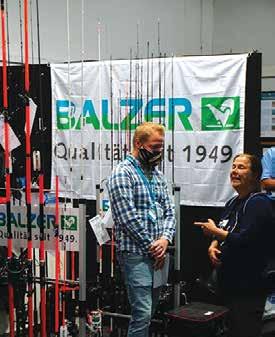
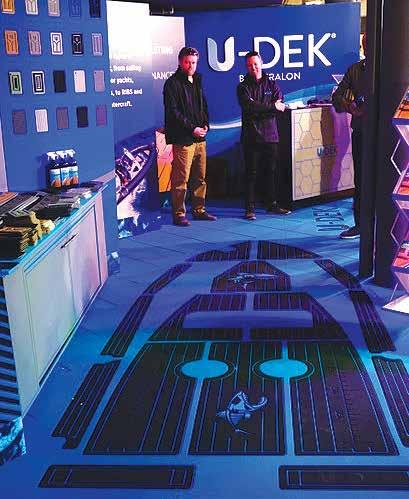
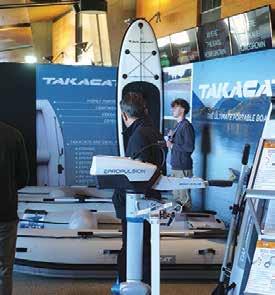






With over 10 years of experience designing boats and marine products for local and o shore clients, RADIAN is Tom Brien’s first step to designing his own brief. With freedom & exploration in mind, he’s created a boat unlike anything else on the New Zealand market, featuring a stern to bow walk-through with high end custom detailing throughout. Venture beyond. www.radianmarine.com



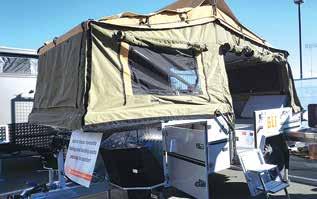


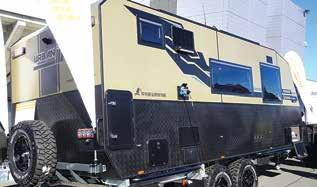





the Eastern Bay of Plenty.
bay beaches for as long as I can remember. At the age of seven, my mother and I lived in a house bus at the Thornton Beach motor camp. The smell of the salty air was instilled in me from a young
The Fishing Paper & Hunting News.
“I live in a small town called Kawerau about a 25-minute drive from Matata and Thornton beaches, my happy places. I’m very much a devoted family man with a wife and three tamariki. I work full time as a machine operator in one of the paper mills in Kawerau and I also own and operate my own business on the side called Mobile Fleet Wash, offering trucking and earth moving companies a fully mobile eco-friendly heavy haulage pressure washing service direct to their site in
waiting for the school bell to ring so I could run to the the Thornton campground’s owners. Was only mullet, herrings and kahawai we would catch but to me it was the best times in the world.
Over the years, I have never lost my passion for
off boats and off the rocks, however, surfcasting is where my heart’s at. My passion and keenness in the sport even landed me a gig on the ITM Hook Me Up TV show a couple years back, with the man himself, Matt Watson. That sure was an eye opener and such a great time.
Through the sport I’ve


made many lifelong friends from being a part of various surfcasting clubs and travelling to different towns attending surfcasting comps.
Most of my surfcasting is done during the cover of darkness and I will usually fish a full night because the fish will show up at some stage; it just takes a lot of ca eine to keep me awake. I fish Matata, Thornton and, quite often, further east Omaio Bay, as we have a whanau homestead there.
My favoured tide for Matata and Thornton is a high tide that falls around
that I’m targeting, snapper, don’t feed till after 11pm and will carry on feeding into the early hours of the morning. Matata is a deep beach and on the low tide can still be too deep to wade through the guts to get your bait out the back.



However, 15 minutes up the road, Thornton can be an a low tide, wading out onto the outer bars to get your bait OTB—Out the Back. Lots of fun when you’re
We are very spoilt for choice in the sunny eastern bay. This amazing coastline can throw up some amazing trevally, kahawai and, in the colder months, gurnard. Both beaches have great to drive along the beach to
Truck is my bed when I’m ready for a kip.



of the new range rods by Tica. In my opinion, they are awesome; very wellbuilt and affordable rods for the serious angler. These rods are of high quality, have a lot of power in the build, giving you an accurate cast. Improving your achievable with these rods.
The line I run is 6kg mainline to help with distance. The lighter line, paired with a tapered shock-leader to take the grunt of the cast, will help increase distance, while preventing a snap o on your cast.
barrel swivels, along with swivel clips and mainly use the old school running rig. The reason why I use such small swivels is to help


Recurve hooks are my go to. I feel once hooked
more fun playing and really
beached, rather than the beak hook where I would panic at times, hoping the Kahawai have a tendency to dance and breach out of the water with a huge fuss when hooked but, if you’re using a recurve hook, they aren’t going to get off. Kahawai
tackle—along with the lighter mainline, opposed to big chunky swivels—helps achieve more distance in your casting.
There are various pulley rig systems out there to increase casting distance and I do rate them highly, however, I’m stuck in my ways and love the running rig. It’s simple and it works for me. Distance is a great ability to have but not essential. The for me a few times. But to able to cast out the back is an advantage.
All my traces are no longer than 30cm and I like to use a 30kg or 40kg line for my trace, with a single size 4/0 recurve hook—either Trokar, KLT or Wasabi hooks. My traces always have a bit of bling on them: lumo beads,

grounds in areas like Omaio Bay and Te Kaha, not needing a huge cast, I made a contraption that works for me: I can cast from the shore out to the foul grounds without getting snagged or ball rig. Quite simple to make but requires a bit of mucking around in the shed but will save you a lot in $$ from losing tackle as that can soon add up.
The tennis ball has a hollow tube running through it, glued in place. A swivel tied to my main line and a 30cm line through the hollow tube tennis ball, with a swivel at the other end
of the 30cm trace acting as a stopper for the tennis ball. I then tie a 1m long trace on the other end of the swivel, the business end, with a single ball sinker free running above the hook to help the bait sink once for the rocky bays and the kids love watching the tennis ball disappear underwater
Then the real fun begins. effective and it stops me from losing a lot of tackle along the way.
Thank you for taking the time to read a bit about me
The main baits that I use for snapper, kahawai, trevally and gurnard are: anchovy, octopus and cray tail. I also like to use piper in hope by one. I rig small pinky to gain that distance in the casting. I’m currently testing a product new to NZ shelves called Fishbites. It’s a company based in California and has proven to work well there and showing good results here in NZ waters as well. It’s a clean and you can use on its own and or with natural baits. A strip of Fishbites has a synthetic is only activated in the water. snapper with Fishbites tipped on my natural baited traces.


but shouldn’t have been when I saw he was just a typical Kiwi boy from up the East Coast but a Kiwi boy who just happens to have the letters VC behind his name.
He did look a bit different from when he was on television in his army number ones and even different for the impressive photo that probably shouldn’t have been published. That was the one with him walking down a street in Afghanistan with another soldier, submachine guns cross their chests and personnel wear.
You’ll probably have guessed by now the man I was honoured and privileged to shake hands with was Willy Apiata VC.
a sheltered life and have found myself in the odd have been involved, it pales when compared with what this man has been through while serving his country. I suppose I was a bit surprised

Brian Bishop
I travelled up with one of our new club members, Chris, who is also a range work through the weekend, helping run the competition. A bonus of refereeing the event, is they get to shoot before the main competition, in what we call a pre-match. Consequently, I got the chance to watch a lot of people tackle the different stages with a variety of
To be fair, I’m a lousy spectator though. I don’t mind watching others if I can have a go in a few minutes, but just watching others with
Well, the Prime Minister, her government and the over-paid senior public servants plus those in local government especially Rotorua are still pissing me off. This month however I’m going to be strong and attempt to ignore the damage they are doing to me and my lifestyle plus of course the rest of the country. I’m not even going to complain about the physical and mental abuse I’m subjected to by my wife of 45 years, Lynne the Ruthless. Apart from the aforementioned, life is actually pretty good. Life
if Jacinda was gone and my boat fuel was a reasonable price but let’s not get into that.
Yesterday I had a and got my limit of seven snapper without too much problem. Nothing huge, with the biggest going eight old fashioned pounds. For the last couple of winters, I have found trout to be about the best snapper bait and
kept was on skipjack tuna. have been a bit hard to catch in recent times. They buy and self-destruct when thawed out, while trout stays on the hooks and can survive
comes along. There’s only one thing, the best trout bait are the bright orange ones people like to smoke.
almost sacrilege to use trout as bait. I don’t subscribe to that opinion. We use mullet, trevally and kahawai for bait all of which are far better eating than trout, with the latter two being way better department there is no comparison.
Well, that’s about all. My grandson has been feeding a pond on his parents’ farm and we’ve been getting a few ducks of an evening. He’s just turned 11 so later this year I’ll pull out the 410 and give him a few shots. That is of course if he wants to shoot. He’s more than happy just being there at the moment so I’m not going to push him.
Like I said earlier, life is pretty good.
take any short cut I can.
sucks, especially when Chris kept ignoring advice I had freely given. How rude—haha, I pointed that out too!
Reading the different
determining the best way to shoot and move around the course can be the difference between winning and losing—big time. A bad move can cost serious points and time, both of which are crucial for a good score.
This can take a while to learn and get proficient at, and the habit of thinking out of the box can help here.
with the easy way and what looks obvious or what the person before you has done; a bit like follow the leader. Whilst this will get the job done, it is not necessarily as I’m basically lazy, I like to cut the running down and

we motored down the coast
After a couple of drops with the lines, we had enough blue cod for dinner.
The organisers had done a great job at setting up quite
with small target zones and plenty of penalty targets too. A hit to one of these
all part of the challenge. I witnessed some very good shooting, which just shows the good skills of my fellow competitors and sportsmen and women. Pistol shooting is a very inclusive sport, with no discrimination of to do their best and follow the safety rules, which have been ingrained into each and every one of us. Training never stops and learning carries on, as we can always get faster or shoot straighter or, for me, I need to do both! No matter how fast I went, Ryan, Lance or Bevan, to name just three, went faster than I did.
This was a very wellrun competition and was appreciated by us all.
Once anchored in Milford nights in the tranquil waters, waiting for another three of our mates who drove down with their trailer boat.
We couldn’t resist going for a tank dive to check out the black coral and catch a feed of crays. Once the other three boys turned up,
free diving, with plenty of crays around for a feed and a few to take home. We actually found it harder to āua, so we set out looking for some, trying a few different spots. Rolling off the boat, I managed to drop straight in on this good looking moki, so I got the boys to throw me

good breath, I dipped below the surface and glided into position and then the rest was history.
The following day, before heading back up the coast, we stopped on top of one of the outer banks and hauled in a few groper from the depths. It was a sublime grandeur of Fiordland as a backdrop To put the icing on the cake, our mate Kris tuna while trolling a lure.
It certainly was an adventure to treasure.













Join






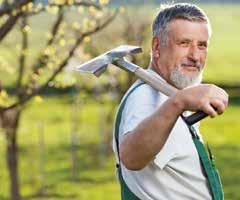



The complaint contends there was no evidential base to support the ban, especially in the Bays’ estuaries, rivers, lagoons, and inlets where locals have set netted for generations without ever sighting a dolphin. In saying that, Fish Mainland fully supported applying the ban where netting poses a risk to incidentally killing or seriously injuring Hector’s or Maui Dolphins.
announced their 2020 decision to impose the ban, two public meetings were held in Motueka to discuss meeting, a show of hands demonstrated that attendees collectively had over 1,000 with some sort of netting method, and almost all had
never seen a dolphin.
Worse still, almost all were unaware of the mid2019 consultation process or the lead up to the 2020 Ministerial announcement to impose the ban. For many, it came as a complete surprise. The Hon Damien O’Connor attended the meeting. He acknowledged lack of awareness of the consultation process and the lack of information on
hold a meeting in Motueka concerns and proposed
declined while asserting, “We consider that there interested stakeholders to input their views on the proposals”.
Fish Mainland pursued all other options to address the ban, including appeals to the Minister of Oceans and Fisheries, the Hon David Parker. It was apparent that the Minister’s responses were
every incentive to defend their prior advice and actions
scale information that might question the legitimacy of risk-based assumptions about dolphin mortality.
The only recourse left available was to lodge a complaint to the Regulations Review Committee based on
grounds that the committee may decide to investigate and make a recommendation to parliament. The committee is chaired by the National Party’s Chris Penk MP and includes one of the Ministers who announced the ban, the Green Party’s
The complaint was supported by submissions from several locals and the Mapua Boat Club. It was also supported by MPI’s own 2021 research procurement the dearth of information on dolphin distribution in Golden and Tasman Bays and the poor-quality, risk-based assumptions used about the impacts of

Nonetheless, the Regulations Review Committee decided that our complaint did not meet the threshold for investigation, even in relation to the consultation process, which the committee referred to
differ, since the voices of
were not heard prior to
the decision to impose the ban. A factor worth noting is that set netting is generally undertaken by older age groups who are far less inclined to access the media channels that
The consultation process was stacked in favour of DOC,
that fully utilised media channels to pad the number of submissions in support
of ‘saving the dolphins’, despite most not having any better understanding of the local situation than did
The inclusive, collaborative approach that Fish Mainland follows highlights the point that had it been set up earlier and involved in the proposed ban from the start, the outcome might have been different.
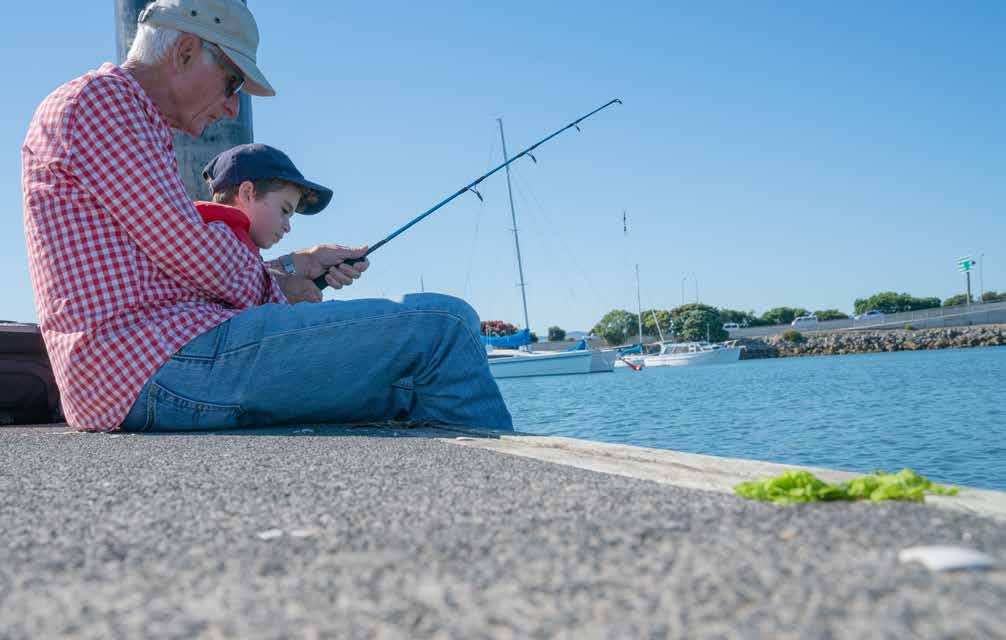

nationally co-ordinated ensures product quality and
This is enshrined in its name, policy and actions, throughout New Zealand). However, there is far more to NZDA than this core proposition and Nelson Branch demonstrates this in its actions and activities in a very clear way! Other support or indeed is work) also occurs in training, competition shooting, provision of safe competitions, training and practice) and by no means least, conservation work such as pest plant and animal control.
Training is provided annually through the
Most trainees are younger but adults wishing to get started in the sport on the right foot also sign up to get all the basic skills set from the get go.
We are lucky to be the “owner/operator of a very good range at Packers Creek and also have management oversight of the community range in Muchison. These ranges not only provide the perfect place for safer training they are also venues for national and international events. Remember all our Commonwealth and Olympic competitors in the shooting disciplines use such ranges all round New Zealand! Further, hunters are operating correctly and accurately can do so in safety and under controlled



conditions. Going hunting without being certain of your the way.
In line with many other clubs around the country we undertake work to support DoC or other landholders to control animals or eradicate pests.
A relationship with the local Wairoa Mountain Bike Park has allowed us the situation) to take care of some of their concerns. Let the numbers do the
189 goats, 47 pigs, 231 possums, 7 feral cats dealt with and 66 Vespex stations filled for wasps…(we can’t count the wasps!).
been the provision of safe and nutritious game animal meat to local foodbanks.
Back on the home range a trapping campaign at Packers Creek has yielded 4 ferrets, 9 weasels, 29 possums and 4 feral cats. It under our noses!
Other work has been done with local DoC who with Helicopters Nelson and great pilot Toby Reid to

train members to be safe “in
and general chopper safety
into more remote places. This is great to be “ticked off” for DoC work and their safety plans as well as for hunters wishing to use choppers at other times.
DoC also support weka and kiwi aversion training for indicator hunting dogs which
are so helpful hunting.
provided over 220 person hours on wilding pine eradication in local areas as well as supporting a goat control programme in Kahurangi National Park.
But yes! Of course we go hunting and support our members in that too. If you will look at how we do that!













“During recent inspections of boats at sea, we gave infringement notices to
had undersize blue cod on their bait boards,” says MPI Regional Manager for the Jay.
Blue cod is an iconic fish in the deep south.
Fishers who are caught in possession of blue cod that is less than 33 cm or in an unmeasurable state risk an instant $250 infringement notice.
If evidence is found of more serious o ending – MPI could put the matter before the court where the penalties could be as high as a $10,000 fine.
“It has never been an acceptable practice to take undersize blue cod or use
pressure and catch limits in some areas have been


reduced to ensure it will be sustainable into the future.
take a hard line on this simply unacceptable and unnecessary,” Garreth Jay says.
In October 2020, blue cod daily catch limits were pressure on southern blue
cod stocks because of concern about sustainability
size was also increased from 30 to 33cm.
It should be noted that the areas in the Otago and
The blue cod daily catch Taiaroa Head is 15, while
the limit north of Taiaroa Head is 10. There is a lower blue cod daily limit of 2 in the East Otago Taiapure area which runs between Karitane Peninsula through to Purakaunui.
“The rules are there for a reason and when we


months there have been 42 individual cases of people using blue cod as bait,” Garreth Jay says.
MPI encourages all
area. The best way of doing this is to download the NZ Fishing Rules mobile app.
Meanwhile, to further highlight the pressure on
blue cod, from October 2021, the commercial total allowable catch for blue cod were reduced by 20% in Otago and 40% in
If

“There comes a point where dreams become reality and reality becomes a after hauling in a marlin Nelson. eels up to two feet in
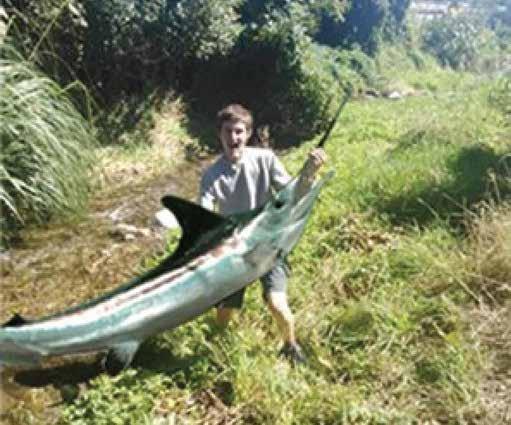

comes completely out of the
“I saw a few whitebait and an eel earlier on in the trip, but there was no precursor recounted.
secrecy, we suspect the marlin was caught towards the mouth of the stream, near the airport.
Local hero and Poorman’s
marine creatures larger than in the stream. The largest he had personally seen in the stream were “little inangas”.
When told about the he was “quite impressed”.
“I’d want to know what lures they were using, because I’d quite like to have a crack at that.”

Team) representative Emma Barnes-Wetere was unsurprised by the catch.
“Due to the intensive sea observed as a result of the climate crisis, it comes as no surprise that there has been a surge of marine biodiversity in the stream,” she said. has hung the bill on his wall and is planning a “mean feed”.


20 years ago, Tinder took the world by storm. Today the hunting world faces a similar phenomenon, Hunting HQ
Bringing hunters, farmers, and landowners together for a match made in hunting heaven. In this Tinder meets Airbnb situation hunters get to shoot game on prime land, while the landowners get the benefit of free pest control and more!
Grant Shanks sat down with Marc Featherstone, CEO of HuntingHQ, to discuss the business, backstory, and benefits of this groundbreaking service.
“I hit on the idea of establishing a company that would put hunters and landowners together in a the problems of access to private land, mainly due to liability issues, came up as the number one frustration

for most of them. I decided there had to be a way to accommodate both parties. It took about a year of planning to bring things together. We’ve now been operating for more than a year and are growth in membership, and that includes hunters and landowners who are coming on board.”
For hunters’ membership is $249 annually to hunt on quality, private land safe from liability issues that could normally occur.
“We have properties from the very Far North to the
These include high country stations, farms, forestry blocks and reserve areas. All are premium hunting properties and they are available for our members. We provide the contacts, the overall management for both landowners and hunters.

We’ve negated liability problems, something that has been a major hurdle for landowners over the years, by taking out ten million dollars of liability insurance to cover both parties.”
While hunting was the initial focus of the operation, HuntingHQ has grown to and a variety of clientele.
“We have products and producers offering huge discounts on a wide range of products and services.
Family groups are welcome on most properties, accommodation, from campsites and shearer’s available as required. Many people want trekking, horse riding, mountain biking, gliding terrain, in addition to hunting. The majority of our landowners can accommodate many of these side options as well as the hunting aspect. It’s a whole new world waiting for our
members out there. Access, the security of knowing your party is the only one hunting on the land, and a huge liability insurance backupit’s a potent combination.”
Are you looking for the perfect match?
Go to
www.huntinghq.co.nz and see what HuntingHQ can provide for you. You may be pleasantly surprised.





